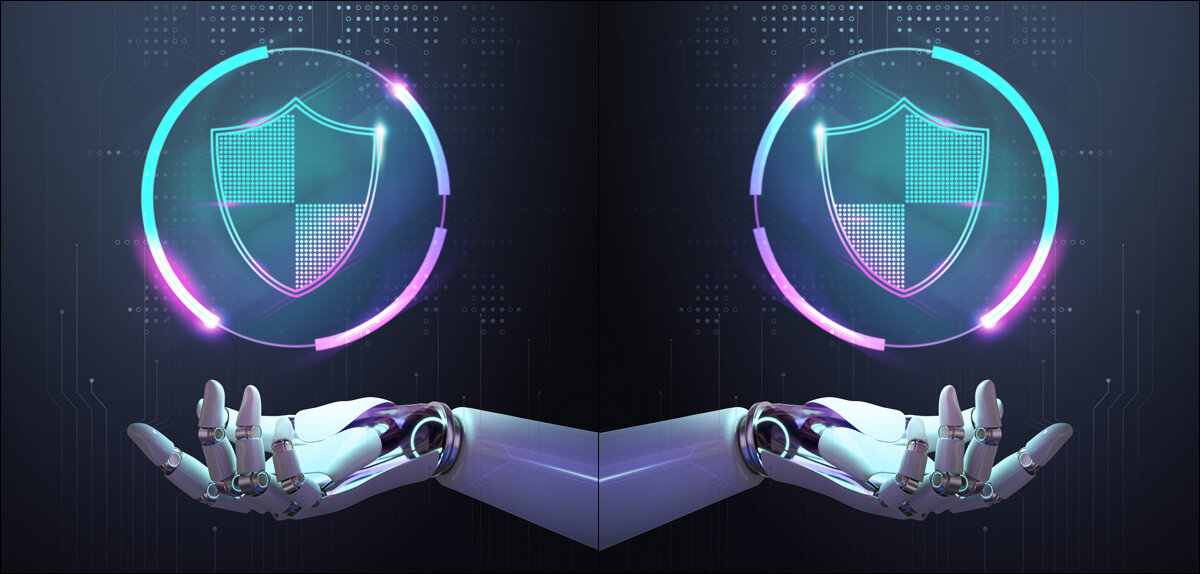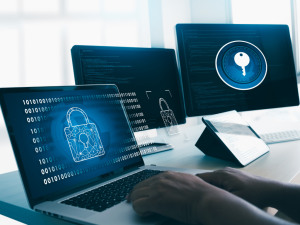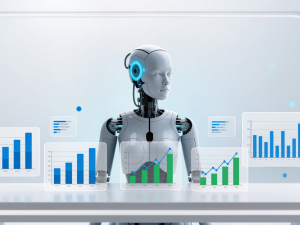Cybersecurity has always been a race between attackers and defenders, but AI has changed the pace of that race entirely. Threats that once took weeks to develop can now be generated in minutes. Phishing emails that used to be easy to spot now read like they were written by someone inside the company. Deepfake audio can mimic a CEO’s voice well enough to trick finance teams. And malware no longer behaves like a predictable piece of code; it mutates, adapts, and learns its way past whatever stands in its path.
This shift didn’t happen gradually. It hit fast.
Security teams started noticing attacks that didn’t fit any known pattern. Tools couldn’t flag them. Analysts struggled to classify them. And the usual playbook patch, isolate, scan, repeat suddenly wasn’t enough. The attackers weren’t just hiding better; they were thinking better. That’s what AI brought into the picture.
For students preparing to enter cybersecurity, this reality changes everything. Slide-based lessons, predictable labs, and outdated examples won’t prepare anyone for threats that evolve in real time. Defending against AI-powered malware requires a completely different kind of training—one built around behavioural analysis, hands-on simulations, rapid decision-making, and the ability to recognise patterns that human attackers never had the speed or intelligence to create.
The cybersecurity world has stepped into a new era, and training must rise to match it. This isn’t about adjusting a few modules. It’s about preparing learners to face threats that rewrite themselves, hide behind legitimate activity, and respond intelligently to defender actions. The next generation of cybersecurity professionals will be dealing with attacks unlike anything seen before and the way they learn has to reflect that reality.
How AI-Powered Malware Is Rewriting the Threat Landscape?
The first sign that something had changed came from malware analysts who noticed their tools weren’t keeping up anymore. Files that looked harmless one minute morphed into something entirely different the next. Attack signatures that used to stay stable long enough to analyze now shifted every time they were scanned. It wasn’t human creativity driving that change, it was AI.
AI-powered malware doesn’t behave like traditional threats. It doesn’t follow predictable patterns, repeat familiar attack paths, or stick to one disguise. It adapts. It studies the environment it lands in. It rewrites its own code to bypass whatever security tools it detects. Every copy of the malware behaves slightly differently, making detection far more difficult than before.
One part of this evolution is polymorphism, where the malware constantly changes its appearance to avoid signature-based scanners. But AI takes this much further. It doesn’t just change its look; it changes its strategy. If a device has strong endpoint protection, the malware shifts tactics and targets weak network rules instead. If email filters become smarter, AI-generated phishing attacks start mimicking writing styles, corporate jargon, and even employee behaviour patterns.
The result is an attacker that can think faster than human defenders.
Phishing emails created by AI look frighteningly accurate in tone, grammar, sentence flow, all tailored to the victim. Deepfake audio adds another layer, allowing attackers to impersonate executives convincingly enough to approve wire transfers or authorize system access. And in more advanced cases, AI is used to create malicious payloads on the fly, generating fresh code that security tools have never seen before.
Security teams aren’t just fighting malware anymore; they’re fighting a system that learns, adapts, and improves with every failed attempt. And that shift changes the entire foundation of cybersecurity. Tools that rely only on known threats can’t keep up. Analysts who rely on old attack patterns will be caught off guard. And students entering the field need to understand one thing clearly: the enemy is no longer static.
AI has made cyber threats more agile, more deceptive, and far more unpredictable which means the skills defenders need must evolve just as quickly.
How Cybersecurity Training Has to Adapt to AI-Driven Attacks?
The rise of AI-powered malware exposed a simple truth: you can’t defend against a shape-shifting enemy with training built for yesterday’s threats. The old model memorize attack signatures, learn fixed procedures, follow pre-written playbooks falls apart the moment the attacker starts rewriting its own code in real time. Defenders need a different kind of training, one that mirrors the unpredictability of the threats they’ll face.
That shift starts with training environments that behave like real attacks, not scripted classroom exercises. Static labs where everyone follows the same steps won’t cut it anymore. Learners need simulations that change based on their decisions, attacks that intensify if they respond slowly, malware that shifts tactics when blocked, phishing attempts that adapt if the student hesitates. When training becomes dynamic, students stop thinking in terms of “right answers” and start thinking like defenders.
AI-powered platforms make this possible. Instead of giving every learner the same scenario, these systems watch how someone responds and adjust the difficulty on the fly. If a student keeps missing behavioural red flags, the simulation throws more subtle anomalies at them. If they struggle with privilege escalation, the next scenario quietly pushes them into dealing with it. It feels less like a lesson and more like a sparring match and that’s exactly what prepares someone for a world where cyberattacks never stay the same.
But adapting cybersecurity training isn’t only about the attacks themselves. It’s also about preparing learners to use AI-driven defense tools. Modern security stacks rely less on signature detection and more on behavioural analytics, anomaly detection, deception technology, and continuous monitoring. Students need to understand what these tools are actually doing in the background, how they analyze patterns, why they flag certain behaviours, and how to interpret the insights they generate.
There’s also a growing need to teach defenders how to recognize AI-enhanced social engineering. Phishing emails are more believable now. Deepfake audio is more convincing. Scam messages sound exactly like the people they imitate. If learners don’t know how these attacks are created, they won’t know how to spot them. Training has to focus on the psychology of deception, not just the technical footprint.
And then comes the mindset shift defenders must learn to be proactive. When malware can generate new variants within seconds, reacting slowly isn’t an option. Training needs to push learners to isolate machines quickly, identify likely attack paths, model potential escalation routes, and act before the attacker gains momentum. It’s not about waiting for certainty anymore; it’s about recognizing risk patterns and moving fast.
In short, cybersecurity training has to become the opposite of static. It has to be alive, adaptive, unpredictable, and deeply hands-on. Because the threats shaping 2025 and beyond won’t pause, won’t wait, and won’t look anything like the malware of the past and neither should the way we teach people to defend against them.
What Skills Cybersecurity Students Need Now?
AI-powered malware has changed the kind of defender the industry needs. It’s no longer enough to memorize tools, commands, or attack names. Employers are looking for people who can think on their feet, understand how attackers adapt, and respond with speed and clarity. That shift is reshaping the skills students need to build today, especially those preparing for certifications like Security+ and PenTest+.
The first big skill is understanding behaviour over signatures. Since AI-driven malware keeps rewriting itself, defenders can’t rely on static indicators of compromise anymore. Students need to learn how to read logs the way a detective reads a crime scene watching for patterns, spotting unusual behaviour, and understanding what “normal” looks like inside a system. When learners start recognizing anomalies instead of memorizing signatures, they’re ready for the kinds of threats AI produces.
Another essential skill is getting comfortable with deep, hands-on investigation. Modern attackers hide inside networks rather than kicking down the door. That means students must know how to trace privilege misuse, follow lateral movement, and dissect suspicious processes. Certification exams like PenTest+ are already shifting in this direction, pushing learners to prove they can think through problems rather than simply repeat commands. The more time students spend inside interactive labs, the faster these investigative instincts grow.
There’s also a rising expectation that defenders understand the basics of automation and scripting. AI-powered malware operates at machine speed, so defenders can’t afford to respond manually forever. Even something as simple as writing PowerShell or Python scripts to automate detection or containment can make a huge difference. Students who treat scripting as a core skill, not an optional extra, end up far more useful in real-world environments.
Another area gaining importance is social engineering awareness. With AI capable of generating perfect phishing emails and producing voice deepfakes that sound eerily real, cybersecurity students must learn how deception actually works. This isn’t just a soft skill, it’s a frontline defense skill. Learners need to understand how attackers study their targets, how emotional triggers are used, and how to verify identities in a world where a voice on the phone or a message online can be completely fabricated.
Cloud security is becoming unavoidable too. As organizations shift towards hybrid and multi-cloud setups, students need to understand how identity, access, encryption, and monitoring work across platforms. Many of the new AI-driven threats target cloud misconfigurations because they’re often overlooked. Students who grasp how to secure cloud workloads instantly stand out.
Finally, there’s the mindset of comfort with constant change. The cybersecurity landscape won’t stabilize, and students who rely on rigid study habits will struggle. What sets strong defenders apart is their willingness to stay curious, test new tools, explore threat reports, and keep learning long after the certification is earned.
In simple terms, the industry wants defenders who don’t just know what malware looked like in the past but understand how today’s threats think, adapt, and evolve. If students build that kind of skillset, they’re not just passing exams, they’re preparing for a future where AI is shaping both sides of the cybersecurity battlefield.
The Future of Cyber Defense Training — What Happens Next?
Cybersecurity training is entering a phase where static content simply can’t keep up. Threats are changing too fast, AI-driven malware is rewriting the rules, and attackers are no longer operating on predictable timelines. The future of cyber training is going to look very different from the lecture-based, theory-first models many learners grew up with.
The biggest shift is that training will move much closer to live-fire environments. Students won’t just read about ransomware; they’ll dismantle it inside controlled sandboxes. They won’t just study phishing; they’ll be dropped into realistic social-engineering simulations powered by AI that adapts to their responses. Instead of learning attack names, they’ll learn attacker behaviour because that’s the only thing AI can’t rewrite instantly. This kind of dynamic exposure will become the baseline for anyone preparing for Security+, PenTest+, or higher-level certifications.
We’ll also see a much tighter connection between defensive tools and training platforms. Security teams already use behavioural analytics, automated detection engines, deception networks, and AI-powered monitoring. Training programs will start integrating these tools directly into learning paths. Students won’t just hear about honeypots or anomaly detection, they’ll use them, tune them, break them, and fix them. This closes the gap between classroom learning and real-world defense, which is where most new analysts struggle.
Another change coming is the rise of AI-as-a-training-partners. Not the simplified chatbots we see today, but adaptive systems that challenge learners the way a sparring partner helps an athlete improve. These AI systems will generate unpredictable attacks, provide step-by-step feedback, and escalate difficulty based on a learner’s actual performance. Instead of everyone getting the same content, each learner’s path will evolve naturally based on how they decide, investigate, and problem-solve.
The future will also demand more emphasis on interdisciplinary thinking. AI-generated threats don’t stay in one lane; they mix psychology, scripting, cloud exploitation, data manipulation, and social engineering. Cyber defenders of the future will need to understand how all these pieces connect. Training will shift away from narrow, tool-based lessons and move toward broader, scenario-driven challenges that reflect real incidents, not textbook examples.
Finally, cyber defense training will become more continuous than ever. In the past, a certification lasted a few years, and that was acceptable. But when malware can reinvent itself in seconds, learning becomes an ongoing cycle. The professionals who thrive will be the ones who treat training not as a milestone, but as a habit the same way developers push updates regularly to keep systems alive.
In short, the future of cybersecurity training is more active, more adaptive, and far closer to the real world. AI has raised the stakes, but it’s also opening the door to training methods that are smarter, more immersive, and far better at preparing defenders for what’s coming next.
Conclusion
AI-powered malware isn’t just another trend in cybersecurity, it’s a turning point. Threats that used to take weeks or months to evolve can now reshape themselves in minutes. Phishing emails read like real conversations, deepfakes mimic trusted voices, and malicious payloads are being generated faster than traditional defenses can react. This shift demands a completely new kind of cybersecurity training, one that’s flexible, hands-on, and built around real, unpredictable scenarios.
For learners preparing for certifications like Security+, PenTest+, or moving deeper into cybersecurity roles, the message is simple: the old playbook isn’t enough anymore. The people who succeed in this field will be the ones who learn to think like attackers, practice inside dynamic environments, and stay comfortable with tools and techniques that evolve constantly.
That’s exactly why Ascend Education integrates hands-on virtual labs, adaptive learning paths, and real-world simulations into its cybersecurity courses. Instead of memorizing definitions, students break systems safely, analyze attacks, troubleshoot breaches, and build instincts that actually hold up when the threats get smarter.
AI has changed the battlefield but with the right training, defenders can keep pace.
FAQs
1. What makes AI-powered malware more dangerous than traditional malware?
AI-powered malware can rewrite its code, adapt to defenses, personalize attacks, and generate new variants on the fly making detection and prevention much harder than before.
2. How does AI change phishing attacks?
AI can craft personalized, convincing phishing messages based on a target’s data, behaviour, and communication patterns, making scams far harder to spot.
3. How can cybersecurity learners train effectively against AI-driven threats?
Learners need hands-on experience through virtual labs, real-time simulations, and training environments that mirror unpredictable, adaptive attacks, not just theoretical lessons.
4. Are certifications like Security+ still relevant in the age of AI threats?
Yes and even more so. But learners now need deeper practical experience and must stay updated with AI-driven attack vectors often included in modern certification objectives.
5. What role does Ascend Education play in helping students prepare for modern threats?
Ascend Education provides certification-aligned courses with realistic virtual labs and scenario-based training, helping learners practice cybersecurity skills the way professionals use them on the job.






